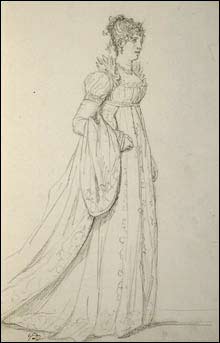
PAULINE BONAPARTE, THE PRINCESS BORGHESE: David’s studies for The Coronation of the Emperor Napoleon I point up the wealth of the Fogg’s holdings. |
In 1946, after two years studying art at Boston’s Museum School, a 25-year-old Ellsworth Kelly returned to France, where he’d served with an Army camouflage battalion during World War II. He jotted glimpses of windows, shadows, branches, chimneys. In four pages from 1950 that are included in “Under Cover: Artists’ Sketchbooks” at Harvard’s Fogg Museum, you look over his shoulder as he studies the striped fabric and odd patches of a cabana on a French beach. If you’re familiar with his trademark striped paintings and monochrome panels, you can imagine how he’d go ga-ga for the abstraction he discovered in the fabric. He pares the pattern down to just the patches, demonstrating his method of editing bits of the world until they become disorientingly abstract while maintaining the particularity of their worldly shape. “Under Cover” is one of those lucid, edifying shows the Harvard museums excel at. Drawing on the institution’s collection, curator Miriam Stewart has assembled 70 sketchbooks and 45 drawings orphaned from sketchbooks from the past 350 years to catalogue, beautifully and precisely, the various species: the artistic diary, the storehouse of sights recorded for future reference, the workbooks in which artists like Kelly puzzle out ideas and designs.

Sanford Robinson Gifford produces tiny precise landscape drawings while searching for fodder for paintings. A facsimile of one of his albums that you can flip through includes a pacific rendering of Harper’s Ferry in Virginia, drawn less than a year after John Brown seized the federal arsenal there and a year before the Civil War began. In 1903 and ’04, Evelyn De Morgan practices drawing hands, feet, the bend of an elbow. In the ’20s, the Reverend Sebastian Gates studies bugs, butterflies, and the downy belly of a dead lesser Antillean tanager lying on its back. He renders them delicately and photographically, as if they were pinned into an album.
The most astonishing testimony to the wealth of the Fogg’s holdings is two books of Jacques-Louis David studies for his famous 1807 painting The Coronation of the Emperor Napoleon I. Here Bonaparte’s sister stands stiffly, there a naked Napoleon holds the crown he will place on his wife Joséphine’s head. Please note that the emperor’s small wiener (talk about a Napoleon complex) does not necessarily represent his true manhood, since the body is drawn from a stand-in for the busy ruler. Again there is a facsimile you can leaf through filled with the cast of thousands in all their finery, the drawings gridded in preparation for transfer to the canvas.
At the turn of the 20th century, John Singer Sargent dashes out groups of people and dynamic gestures for his Boston Public Library murals. In the ’40s, Henry Moore and David Smith plan out sculptures in the late Cubist-Surrealist style it seemed anybody who was anybody employed before Abstract Expressionism burst onto the scene.
Some, like the great draftsman George Grosz, are flattered by the show’s emphasis on drawing. Others, like Cézanne and Manet, are represented by clumsy sketches that suggest their genius lay with the paintbrush, not a pen or pencil.